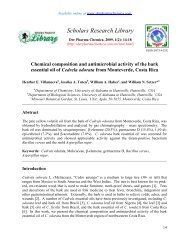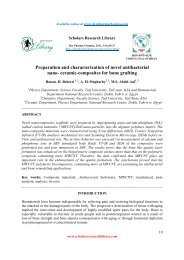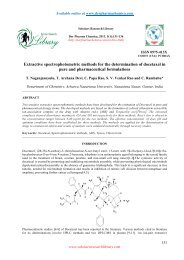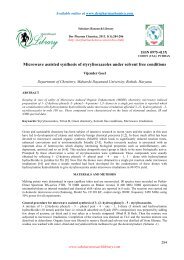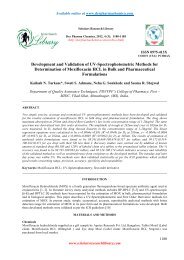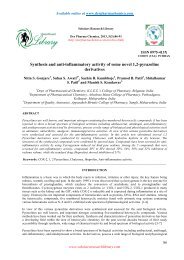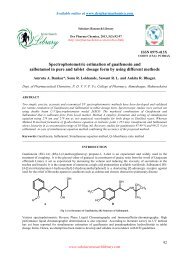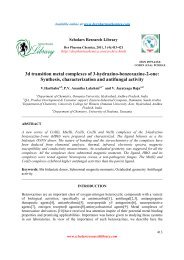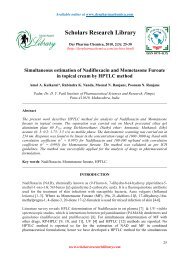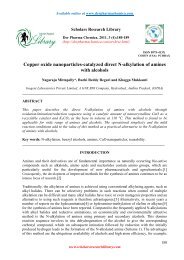Synthesis and evaluation of some novel thiomers as mucoadhesive ...
Synthesis and evaluation of some novel thiomers as mucoadhesive ...
Synthesis and evaluation of some novel thiomers as mucoadhesive ...
Create successful ePaper yourself
Turn your PDF publications into a flip-book with our unique Google optimized e-Paper software.
Rajesh J. Oswal et al Der Pharma Chemica, 2012, 4 (4):1385-1396<br />
_____________________________________________________________________________<br />
The onset <strong>of</strong> temperature (T O ) <strong>of</strong> polymer w<strong>as</strong> 185.86°C, where (T P ) peak temperature w<strong>as</strong> 238°C.The enthalpy w<strong>as</strong><br />
(∆H), -185.86 J/g.<br />
Solubility <strong>of</strong> polymer in different solvents <strong>and</strong> buffer solutions<br />
A study <strong>of</strong> relative solubility w<strong>as</strong> carried out in different solvents <strong>and</strong> under different pH conditions. <strong>Synthesis</strong>ed<br />
polymer w<strong>as</strong> found to be insoluble in water <strong>and</strong> soluble in all organic solvents tested <strong>as</strong> shown in Table 1. The<br />
solubility incre<strong>as</strong>es with incre<strong>as</strong>e in the pH <strong>of</strong> the solution. A low solubility <strong>of</strong> 3.8 × 10 -3 <strong>and</strong> 4.14 × 10 -3 (g/ml) w<strong>as</strong><br />
found at a lower pH <strong>of</strong> 1.6 for CMS-C <strong>and</strong> CMG-C respectively. This indicates a minimum drug rele<strong>as</strong>ing property<br />
in the g<strong>as</strong>tric acid environment. Similarly a higher solubility <strong>of</strong> 23 × 10 -3 <strong>and</strong> 37.4 × 10 -3 (g/ml) w<strong>as</strong> found in the<br />
b<strong>as</strong>ic pH <strong>of</strong> 8.0 for CMS-C <strong>and</strong> CMG-C respectively this indicates a maximum drug rele<strong>as</strong>e in the intestine.<br />
Table.1: Solubility pr<strong>of</strong>ile <strong>of</strong> polymer in different solvent<br />
Solvent Solubility in gm/ml<br />
CMS-C CMG-C<br />
Acetone 2.3 ×10 -2 2 ×10 -2<br />
Chlor<strong>of</strong>orm 2.9 ×10 -2 4 ×10 -2<br />
Ethanol 2.3 ×10 -2 4.04 ×10 -2<br />
IPA 1 ×10 -2 3.2 ×10 -2<br />
Water Insoluble Insoluble<br />
Table.2: Solubility pr<strong>of</strong>ile <strong>of</strong> polymer in different PH solvent.<br />
PH Solvent<br />
Solubility in gm/ml<br />
CMS-C CMG-C<br />
1.6 3.8 ×10 -3 4.14 × 10 -3<br />
4.0 4.8 ×10 -3 9.04 × 10 -3<br />
6.8 9.2 ×10 -3 25.8 × 10 -3<br />
8.0 23 ×10 -3 37.4 × 10 -3<br />
Determination <strong>of</strong> thiol group content<br />
Weigh about 0.2 gm <strong>of</strong> polymer <strong>and</strong> placed in iodine fl<strong>as</strong>k. Add 50 ml <strong>of</strong> st<strong>and</strong>ard 0.1 N iodine solution into fl<strong>as</strong>k<br />
shake it vigorously. Introduce 20 ml <strong>of</strong> ethanol <strong>and</strong> shake for 10-15 min. Titrate excess <strong>of</strong> iodine with 0.1 N sodium<br />
thiosulphate solution using starch indicator near end point [17].<br />
Where,<br />
V1 = volume <strong>of</strong> sodium thiosulphate for blank<br />
V2 = volume <strong>of</strong> sodium thiosulphate for sample<br />
N1 = normality <strong>of</strong> sodium thiosulphate<br />
M = molecular weight <strong>of</strong> sample<br />
W = weight <strong>of</strong> sample.<br />
Table.3: % <strong>of</strong> thiol group content<br />
Polymer % thiol group<br />
CMS-C 76.15 ± 1.30<br />
CMG-C 80.0 ± 2.60<br />
(mean ± S.D,n=3)<br />
Swelling behavior<br />
The swelling behavior <strong>of</strong> <strong>mucoadhesive</strong> polymer h<strong>as</strong> a considerable influence on their adhesive properties <strong>and</strong><br />
cohesiveness. The hydration theory postulates that <strong>mucoadhesive</strong> polymers take water from the underlining mucosal<br />
tissue by absorbing, swelling <strong>and</strong> capillary effect, leading to a considerably strong adhesion [26].<br />
Mucoadhesive drug delivery system can be attached in dry form to buccal, ocular, n<strong>as</strong>al, intestinal or vaginal<br />
mucosa. A prolonged residence time <strong>of</strong> the system on the mucosa leads to an extended period <strong>of</strong> absorption <strong>and</strong><br />
consequently <strong>of</strong> improved bioavailability. When it is directed to the small intestine, it reaches its target site already<br />
www.scholarsresearchlibrary.com<br />
1392



